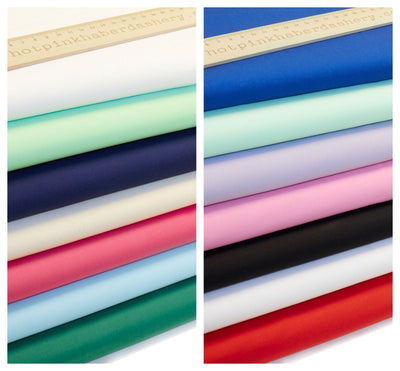How To Make A DIY Christmas Gonk
What Are Gonks?
Gonks have long been part of Scandinavian folklore and Christmas traditions, however thanks to the increasing popularity of Scandi culture, these mythological gnomes are becoming more and more part of our festive decor too.
Although Scandinavian gnomes are known by different names in each of the region’s countries, they share very similar origins and stories. In Sweden & Denmark, the gnomes are known as “Tomte” and in Finland their name is “Tonttu”. In Norway, they are called “Nisse”, derived from the name Nils, a Scandinavian form of St Nicholas. These gnomes were renamed as 'gonks' in the UK and have been enjoying a resurgence in popularity here. Like gnomes of Western mythology, they are believed to be short in stature with a long white beard and can be a little mischievous!
What Are The Legends Of The Scandinavian Gnomes?
The Swedish name Tomte comes from the word “tomt” meaning homestead, so “Tomte” translates literally as ‘homestead man’. The spirit of the gnome is believed to protect and care for the welfare of a farm and its much valued livestock, by embodying the ancestral soul of the original farmstead owner. As farms are usually isolated on large areas of land, these ancestral figures provide a sense of companionship during the long, dark winter months for the inhabitants.
However, gnomes have a particular character which must be respected, otherwise they will cause mischief and mayhem! They are believed to work hard but can be offended by rudeness and the mistreatment of animals or the farm. If he disapproves of the farmer’s behaviour, the gnome can play pranks such as tying cow’s tails together or turning objects upside down! A clean, well-ordered home is believed to be a sign that the spirit of a Tomte or gnome lives there and, even as people relocated to cities over recent decades, it is believed that they brought their Tomte spirits with them.
What Does A Gonk Look Like?
The Gonk is described as a little old man, with a big round nose, a long white beard who wears a long, conical red hat, big boots and traditional farmer’s clothing in either grey, blue or green. His appearance was later adopted as the image for St Nicholas, which then influenced Coca Cola’s representation of Santa Claus in their early Christmas advertisements.
Why Are Scandinavian Gnomes Part Of Christmas Tradition?
Legend says that the Tomte spirit sleeps under the floorboards during the spring and summer months, then wakes as the days shorten and become colder towards the winter solstice. As Christmas approaches, he is busy with preparing the home by doing domestic chores and baking sweet festival treats. For Scandinavians, the thought of having a gnome at home is something to be cherished and so, as a symbol of gratitude for his hard work, they leave him a bowl of Christmas porridge with butter, known as julgröt, on Christmas Eve. In Norway, it is also thought that the Nisse spirit will bring presents for children and some families will leave a place setting at the table to invite the Nisse to join them on Christmas Day.
How To Make A DIY Christmas Gonk
Making your own Gonk is a beautiful project for Christmas – it feels so festive! Whether you make a single Gonk or a small cluster to place on the mantelpiece, this lovely craft embodies all the folklore and magical mythology of the season. Here is our easy, step-by-step guide to making a Scandi Christmas Gonk – it's ideal for older children to get involved too!
What Do I Need To Make A Christmas Gonk?
Soft Felt or mixed cotton poplin fabrics of your choice
Batting, such as our Vlieseline 277 Downy Soft Cotton Batting
Matching thread
Round wooden macrame beads, for his nose.
Faux fur, for his beard.
Dressmaking scissors
Fabric Glue

Step 1: Preparing Your Christmas Gonk:
Start by planning how your Gonk will look – you might choose a classic combination of soft grey felts, such as our charcoal and grey colours, with white felt or mix a red felt hat with navy, grey or green felts across his clothing. If you’re familiar with felt making projects, integrating some blanket stitching or festive stitching motifs to your design, can add a beautiful, traditional finish to the Gonk. Otherwise, you could combine some of our cotton poplin fabrics, such as plains or stripes mixed with a festive star print – the creative possibilities are endless! Also, you may like to add 3 dimensional legs and arms to your Gonk – so just adjust the pattern accordingly before cutting these pieces and stuff with the batting.
Once you have your materials selected and ready, cut out each piece of felt or fabric for your gnome. There are free gnome patterns available for download online, to help you or you can draw your own on baking paper to follow.

Step 2: Stitching Your Gonk:
Next, roll the rectangular material for the Gonk's body into a cylinder shape and sew along the seam. Attach the circular base of the body by stitching onto one end of the cylinder, then turn the material right side out. Your cylinder should stand neatly on the base, but you might like to add a cardboard circle inside the body to help the base stay flat. Fill the Gonk's body with soft batting, you can also add some dried rice under the batting if you want to add a little weight. Stitch around the top seam and gently pull the top edges together, leaving a small hole so the sides of the Gonk stay fairly straight.

Now, attach the Gonk's arms and hands together by either using fabric glue or stitching together. If you wish to stuff the Gonk's arms and hands, just ensure to plan this when you cut your material in Step 1. Attach the arms to the top of the gnome’s body, so they hang either side.
Add the Gonk's characteristically large, round nose, by sewing a macrame bead near the top of the vertical seam in his body – this seam will shortly be hidden by his great, long beard. If you’re working with felt, you may prefer to make a felt nose using our flesh colour soft felt.

Next attach your Gonk's great beard with fabric glue to the front of his body, ensuring it covers the full length of his torso.
Finally, sew together the side edges of his conical hat. If you’re using felt, a blanket stitch will look lovely as part of your design. Ensuring the hat is the right side out, add a little batting to the base of the hat to hold some fullness, then glue or stitch the hat to the top of Gonk's body. You can add a pom pom or jingle bell to the end of his hat too, if you wish! Browse our Christmas haberdashery department for festive buttons, bells and other embellishments ideas!

Step 3: Find A Home For Your Gonk!
Whether you make one or a small group of gnomes, find a special spot in your home for your Gonk so – as legend tells us – he can protect and prepare your home for Christmas!
Love Gonks? Check out our Christmas shop for Gonk Christmas fabrics and stickers!
We’d love to hear from you!
We are always inspired to see how our customers use our products, so please feel free to tag us on Instagram or Facebook with photos of your festive creations!
Tell us how you like to decorate your home at Christmas too, by leaving a comment below. Wishing you a happy and creative Christmas season!






Leave a comment